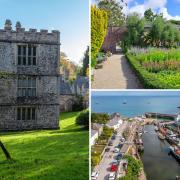Almost a third of Cornwall sits in an Area of Oustanding Natural Beauty. We continue our series exploring the areas. This month we head to South Coast Western including the Lizard and Helford River

The variation in coast and country along this section of the Cornwall AONB is diverse and provides a perfect challenge for keen walkers and cyclists. There is far more to see than can ever be described in a short article but at least providing an insight into what is in store for the visitors to this section will hopefully inspire you to get out and explore.
The iconic rocky granite outcrop of Saint Michael’s Mount is a main visitor attraction, () dominating Mount’s Bay with its cobbled causeway leading out to the castle at low tide. The Church and Priory at the heart of the castle was originally built by Benedictine Monks in the eleventh century and is the Cornish counterpart of Mont Saint Michel in Normandy, France. The Island was given to the Monks by Edward the Confessor in the 11th century. The castle is now the home of the St.Aubyn family and has been connected to the family since the 14th century when Guy St Aubyn moved to Cornwall to marry the heiress of Colquite.
To visit St Michael’s Mount you can walk the causeway at low tide or alternatively catch the ferry if the tide is on the turn but whatever you do make sure you are not caught out by the tide.
Heading east from Marazion on towards the Lizard Peninsula it’s certainly worth stopping off at Porthleven and walking along the coastal path to Gunwalloe where there is an extensive shingle beach forming the Loe Bar which contains the waters of Loe Pool, a freshwater lake fed by the waters of the River Cober.

The Lizard Peninsula with its tall cliffs and small coves offers a marked contrast in landscape. The fishing villages of Cadgwith and Coverack are popular summer destinations for visitors and provide a welcome seasonal boost to the local economy. For those with an interest in geology, the Lizard Peninsula is underlain with serpentine which is clearly visible in the rock strata at Kynance Cove and when the sun shines on the cliff face you can clearly see the beautiful bluey green tinge of the serpentine. The combination of the geology, mild oceanic climate conditions and its southerly location has led to the development of a unique range of heathland types with many rare species of local and national importance and makes the Lizard a very special place for residents and visitors alike.
In marked contrast to the Lizard, the Helford River valley is a haven of peace and calm and almost like a secret kingdom with its exotic plants and hidden creeks, it has its own micro-climate and the National Trust garden of Glendurgan () and the subtropical garden at Trebah () are testament to the amazing beauty of this very special area.
The seaward opening of the Helford River is marked by Nare Point on the one side and Rosemullion Head with its distinctive Monterey Pines on the other, beyond which the river flows out to the open sea of Falmouth Bay. The boundary of the Cornwall AONB then extends on along the coast to the western outskirts of the maritime port of Falmouth stopping just short of Swanpool. There is so much to see in this section of the Cornwall Area of Outstanding Natural Beauty so why not explore for yourself, you will certainly not be disappointed.

ALONG THE HELFORD
The Helford River provides a marked contrast to the rest of the landscape in this section of the Cornwall AONB, with its hidden creeks and ancient Sessile Oaks its individual character and beauty together with its ambience and romanticism has provided inspiration to many artists and writers, most famously in Daphne Du Maurier’s novel Frenchman’s Creek.
The Helford River forms a ria (drowned river valley) which resulted from a rise in sea level following the last Ice Age. As this is a tidal river, at high tide the water reaches up to the very edges of the oak woodland whilst at low tide the exposed greyish mud completely transforms the scene as at Polwheveral and Port Navas creeks, providing a haven for wading birds and wildlife.
As a result of the sheltered aspect of this landscape, it has its own microclimate providing perfect growing conditions for a more exotic collection of trees and plants such as, Rhododendrons, Camellias, Magnolias, Tree Ferns and Palms and these can all be seen in abundance in the gardens at Trebah, Glendurgan and Bosloe further contributing to the special sense of place’ experienced when visiting the Helford landscape.
The village of Gweek is situated at the head of the Helford River and was once an ancient tin mining port (early Iron Age), today it is best known for the Cornish Seal Sanctuary’, a rescue, rehabilitation and release centre for seals, saving over 50 pups each season ().
LOCATION
We are now half way through our journey around the Cornwall Area of Outstanding Natural Beauty (AONB) and have reached the local section known as South Coast Western. This is the second largest section of the Cornwall AONB comprising of an area of 192 square kilometres and extending from Marazion and the spectacular St Michael’s Mount in the west, to just beyond Maenporth on the outskirts of Falmouth in the east and takes in both the Lizard Peninsula and the Helford Passage.
GETTING OUT AND ABOUT
To do justice to this section of the Cornwall Area of Outstanding Natural Beauty you have to allocate quite some time to truly explore the diversity of South Coast Western area.
The South West Coastal Path provides an excellent opportunity to discover hidden coves and high cliffs (southwestcoastpath.org.uk) and the interactive map on the website enables you to gauge the level of fitness required when walking the different sections of the coast path.
i-walk Cornwall also provides lots of useful information on walks within the Cornwall AONB see (iwalkcornwall.co.uk) for further information on walks in this area.
If you are taking the car and want to park in several car parks along the way, Cornwall Council offers a Rover’ parking permit which provides access to some (not all) of the Cornwall Council controlled car parks, see
INFO
If you would like to find out more about the Cornwall Area of Outstanding Natural Beauty please visit where you will find further information about the work they do. From time to time we require volunteers in various parts of the 12 designated Cornwall AONB areas - find out more by dropping them an email at info@cornwall-aonb.gov.uk
WILDLIFE
On the land
This section of the Cornwall AONB extends for some 50 miles and includes a variety of landscape types which in turn provides habitat for a wide range of flora and fauna. Marazion as the starting point, is bounded by the rich turquoise waters of Mount’s Bay whilst to the west of the town lays Marazion Marsh which is the largest fresh water reed bed in Europe and offers a welcome stopping off point for many migratory birds. The Marsh is a RSPB Nature Reserve where more than 250 bird, 500 plant, 500 insect and 18 mammal species have been recorded here and bitterns are now regular winter visitors.
The Lizard Peninsula contains three main Sites of Special Scientific Interest noted for its endangered insects and plants as well as for the geology (Britain’s largest outcrop of Serpentine can be found on the Lizard) and contains nearly half of the British native flora together with 55 rare and special species ()
One of England’s rarest breeding birds the Cornish Chough can be found on the Lizard, the Chough began breeding on the Lizard in 2002 as a result of the work on the Cornish Chough Project’ between DEFRA and the RSPB. Chough’s can be recognised by their red beak’s and legs and resemble a crow with their black plumage.
At sea
Common and Bottlenose dolphins can be seen in Mount’s Bay as well as the occasional Basking shark; leather back turtles have also been recorded. Lizard Point, being the most southerly point in the UK is an ideal location for spotting common species of seabirds such as Gulls, Fulmars, Cormorants, Shags, Guillemots, Razorbills and Kittiwakes and during inshore gales many of the rarer species such as Skuas, Shearwaters, Petrels and Auks are pushed closer to Lizard Point. Dolphins, Porpoises, Basking sharks and Grey Seals can all be spotted along this section of coast.
With its hidden creeks and ancient Sessile Oaks the Helford River’s individual character and beauty together with its ambience and romanticism has provided inspiration to many artists and writers, most famously in Daphne Du Maurier’s novel Frenchman’s Creek’





























